Elden Ring (2022)
Warning
This article contains spoilers for the following topics: Elden Ring, Elden Ring: Shadow of the Erdtree
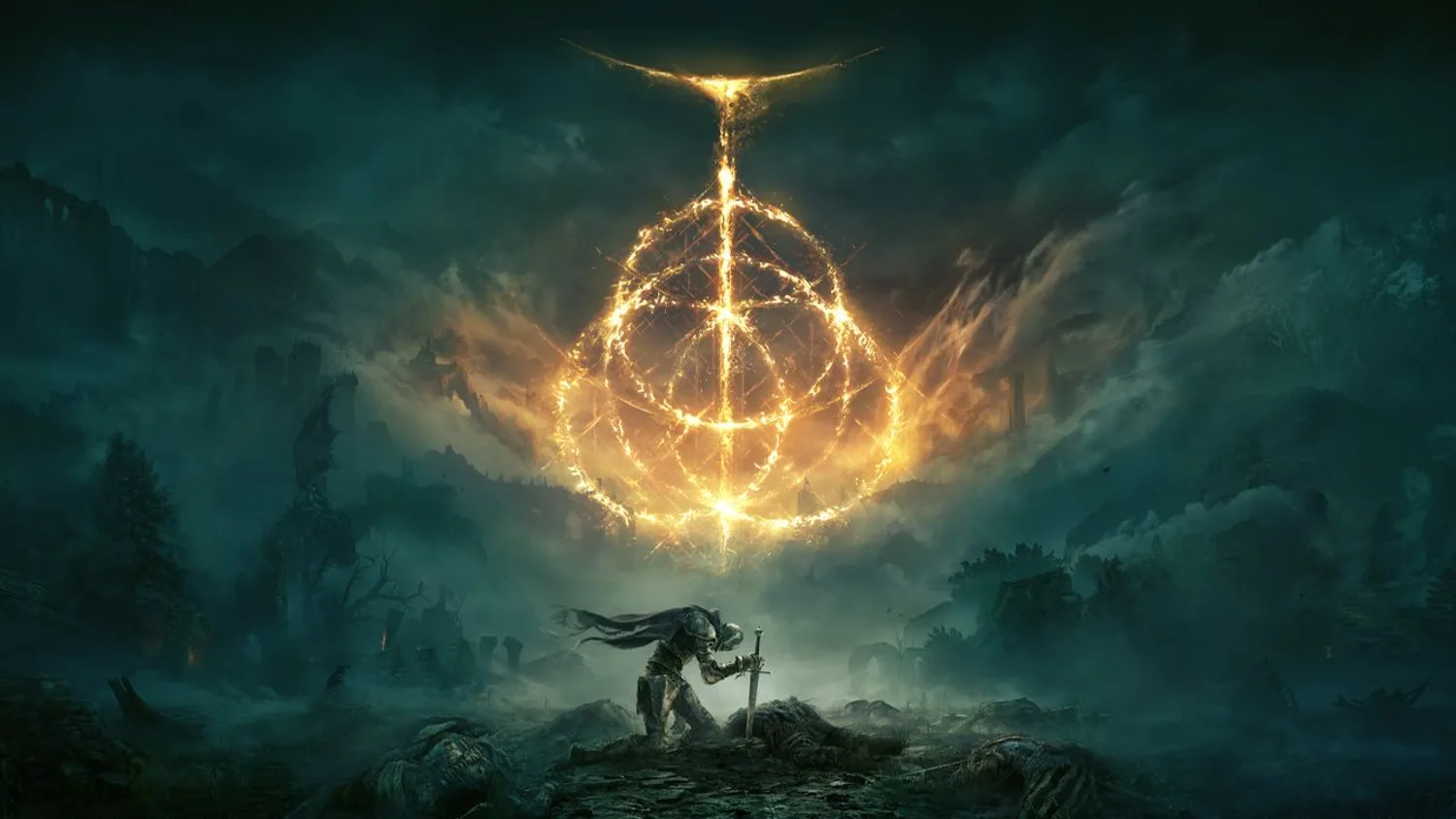
I've been meaning to write about this game for a while now. I've beaten the game multiple times with multiple saves, earned all Steam achievements, have acquired almost every piece of equipment in the game[1], and have spent close to 600 hours in this game - and I've never written about it. So let's finally talk about Elden Ring.
I would also like to mention that I have spent hours meticulously recording a playthrough of the entire game. If you'd like to watch my experience of the game you can watch my series where I play through the entire base game and Shadow of the Erdtree DLC (Downloadable Content). I had a lot of fun playing it!
Legacy of Dark Souls ¶
Before I talk about Elden Ring, I first need to take a step back to talk about a different game also released by FromSoftware: Dark Souls. Dark Souls is a dark fantasy video game that was initially released in 2011 as a creative step in a different direction from the gaming industry at the time. I didn't grow up playing this game but I was fortunate enough to be able to play the remastered edition in the summer of 2019. Dark Souls is very different than most games you'll play. It raises game difficulty to an unmatched level: enemies kill you in two hits, bosses can take hours to defeat[2], and the game's bonfires (save checkpoints) are so spread out that I can still distinctly remember where a lot of the bonfires are located in the world.
And that's what makes this game so interesting: to say this game is hard is an understatement. Because the difficulty is so high, any amount of progression feels immensely satisfying. Here's a great example I have burned into my memory: to get from the Undead Burg bonfire to the next checkpoint, you need to:
- run across a bridge avoiding firebombs
- avoid the stabbing undead solider with the shield
- kill the other two soldiers
- kill the undead standing in the doorway to the side of the stairs
- (optional) kill the undead on the roof/tower if you're paranoid
- kill the three soldiers on the parapet at the foot of the other stairs
- dodge the flaming barrel a solider kicks down, then kill that soldier
- traverse the fog wall and kill the undead archers on the roof of the tower
- kill the Taurus Demon boss
If you die, you must start over again. Even for an experienced player, these checkpoints can be difficult or painful to reach: it takes Jacksepticeye approximately 5 minutes to run through this sequence. Reaching the next bonfire means you made tangible progress, and you often receive rewards (items and equipment) along the way.
Another important game mechanic Dark Souls introduced was the "souls" mechanic. The way your character levels up or gets stronger is by collecting souls from enemies. These souls can then be spent at bonfires to level up your character's attributes. However, if you die, your character loses all of their unspent souls. The only way to retrieve those souls is to run back to the place they were lost. If you die before retrieving them, the souls are lost forever.
Dark Souls's emphasis on difficulty and progression grew so popular that it led to sequels Dark Souls II and Dark Souls III. It also spawned the creation of the souls-like game genre, known for role-play mechanics, ambiguous storytelling, and, of course, excruciatingly difficult gameplay.
There's a lot more to say about the legacy of Dark Souls on video games, but I'm primarily here to talk about Elden Ring. Let's get back to Elden Ring.
Plot ¶
Elden Ring is set in a dark medieval fantasy world known as the Lands Between. Within the Lands Between, the Elden Ring was shattered by Queen Marika. It triggered The Shattering, a war among Marika's offspring to fight for the shards of the Elden Ring to become Elden Lord. However, there was no resolution to the war. Your character, a "tarnished", has the goal to take up the cause, mend the Elden Ring which was shattered, and become the next Elden Lord.
On your journey, you meet Melina who aids you and acts as a "finger-maiden" to help you reach the throne. She grants you the ability to summon Torrent, your spectral steed. You travel through the Lands Between to Leyndell, the capital, and reach the base of the great erdtree only to find that the erdree's thorns block entry to the elden ring. From there, you travel up to the Mountaintops of the Giants to find the giants' forge to burn the erdtree and the thorns. Melina sacrifices herself to kindle the fire, and you successfully burn the thorns, fight your way to the elden ring, and defeat Radagon (Marika) to mend the elden ring. Beside the main storyline, this is the only exposition you receive from the game. The rest is discovered through exploration, item discovery, and talking to characters. You, the player, need to seek them out to understand the world.
This is a quality I love about Elden Ring and other FromSoftware games. Their storylines are always hidden, ambiguous, and completely open to interpretation. Rather than being spoon-fed information, you have to draw your own conclusions based on your discoveries and observations as to what happened. Ambiguity is such a powerful tool in writing a compelling story because it allows the audience's mind to wander creatively and fill in the gaps with their imagination. It incites discussion, deep lore, and community, and it's something FromSoftware excels at. There's a reason why universes like Marvel and Star Wars have so much to explore: they leave breadcrumb trails of story and allow their audience to fill in the gaps and speculate characters' backstories and motives.
Elden Ring tells a loose story of multiple subplots to dethrone Queen Marika but leaves even more questions unanswered. Why was the Elden Ring shattered in the first place? Who is Queen Marika? Why did Radagon leave Rennala? What was the "original sin"? I'll stop trying to explain lore here because there are so many lore speculations and videos that do a much better job answering these questions.
It is worth mentioning that the elden ring itself is not a physical ring you might put on a finger. Rather, it is a collection of great runes (powerful glyph fragments) that grant power to the beholder. It reminds me a bit of the power of the ring in Lord of the Rings in that it has an ambiguous power to dominate and subjugate. The game is never explicit in what the elden ring "does" but its power is demonstrated in various ways such as grafting, physical strength, and rebirth. Each great rune you acquire fits into the bigger symbol of the elden ring.
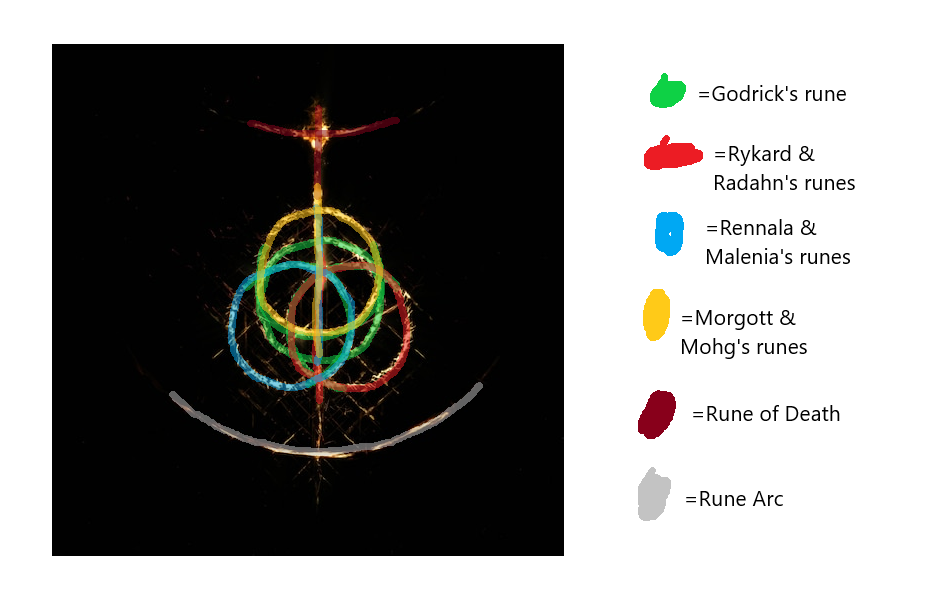 Source
Source
You can see George R. R. Martin's influence in the writing of the characters based on their convoluted (and incestuous) bloodlines. The family tree of Marika's offspring can be very confusing so I've made a diagram to help clarify relationships:
Rellana ┌──Ranni │ │ Rennala ├──Rykard │ │ ├────────┴──Radahn │ Radagon ┌──Malenia─────Millicent │ │ │ ├──Miquella ├────────┤ │ ├──Messmer │ │ Marika └──Melina │ ┌──Godefroy │ ┌──Godwyn───┤ │ │ └──Godrick ├────────┼──Morgott │ │ │ └──Mohg │ Godfrey───────Nepheli
World and Atmosphere ¶
FromSoftware employs what I call "world-building level design" in all of their souls-like games and Elden Ring is no exception. World-building level design is when a "level" in the world is just a small piece of the world, and connecting all these pieces physically forms one cohesive world. In most games, levels are distinct bubbles that have no connection to the other levels of that universe. However, in Elden Ring, each "level" is a different area in the large map of the world. Limgrave connects directly to Caelid and Liurnia and the player can travel via Torrent between the three different areas. You can almost traverse the entire map without fast travel or cutscene interruptions.
Visuals ¶
Within the world, each area looks astounding. Each area is a vista of colors, atmospheric fog, and details visible in the distance.
Let me use Liurnia as an example. Below is a screenshot taken from my playthrough:
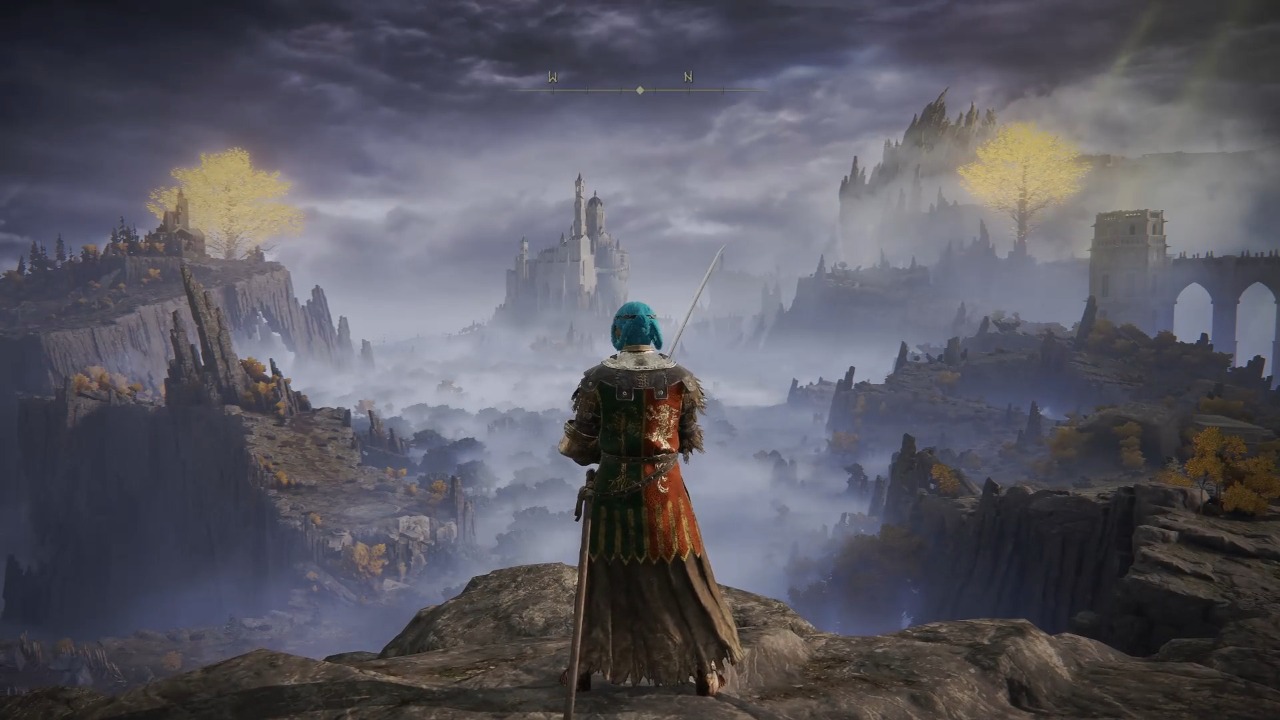
On the far left you can see the Moonlight Altar with the Cathedral of Manus Celes on top of the cliffs. Just below that is an evergaol. At the center of the screen, you can see the academy of Raya Lucaria where Rennala dwells. Then, to the top right, you can see Mount Gelmir where the Volcano Manor resides. Below the academy is the fog-filled swamp that is the lakes of Liurnia. It blows my mind how much detail you can see in these distant areas before even reaching those areas. Even in the DLC you can sometimes see large enemies from afar. There is so much effort put into the graphics to render these areas impeccably from a distance and up close.
Each area has a different color theme as well - Limgrave is yellow/green, Liurnia is blue/purple, Caelid is red, the Jagged Peaks are orange/red, and so on.
This is all to emphasize the sheer amount of content Elden Ring gives the player. The map is massive without even considering the three main underground areas.
Music ¶
Within each area, the music tells a story that supports the visuals. Somber music is played to accompany sad areas, choral dark music accompanies dangerous areas, and mysterious music plays in shrouded or veiled areas.
Music is also used to tell a story. The main theme that plays on the menu screen also plays when fighting the final boss to tell you the player that they're at the end of their journey. Tragic violin music is played by some merchants that have lost their minds to the frenzied flame - sitting amidst bodies of other merchants. A theme with suspenseful strings and bells plays when the player has reached the top of a divine tower to mirror reaching the top of a bell tower, or reaching a high altitude.
Environmental Storytelling ¶
Every area in Elden Ring tells a story about its origins and background. This is called environmental storytelling and is the video game equivalent of "show, don't tell". Elden Ring excels at environmental storytelling: it leaves behind items, structures, and music to tell a story. For example, when you enter the capital of Leyndell for the first time, you see ash and crumbled buildings everywhere. You can infer that the capital is no longer in its prime, and that the erdtree was burned once before. Another example is Midra's Manse, where all books are burned and inquisitors patrol the halls. You can infer that some form of heresy or forbidden knowledge (frenzy) was acquired at the manse that should not exist.
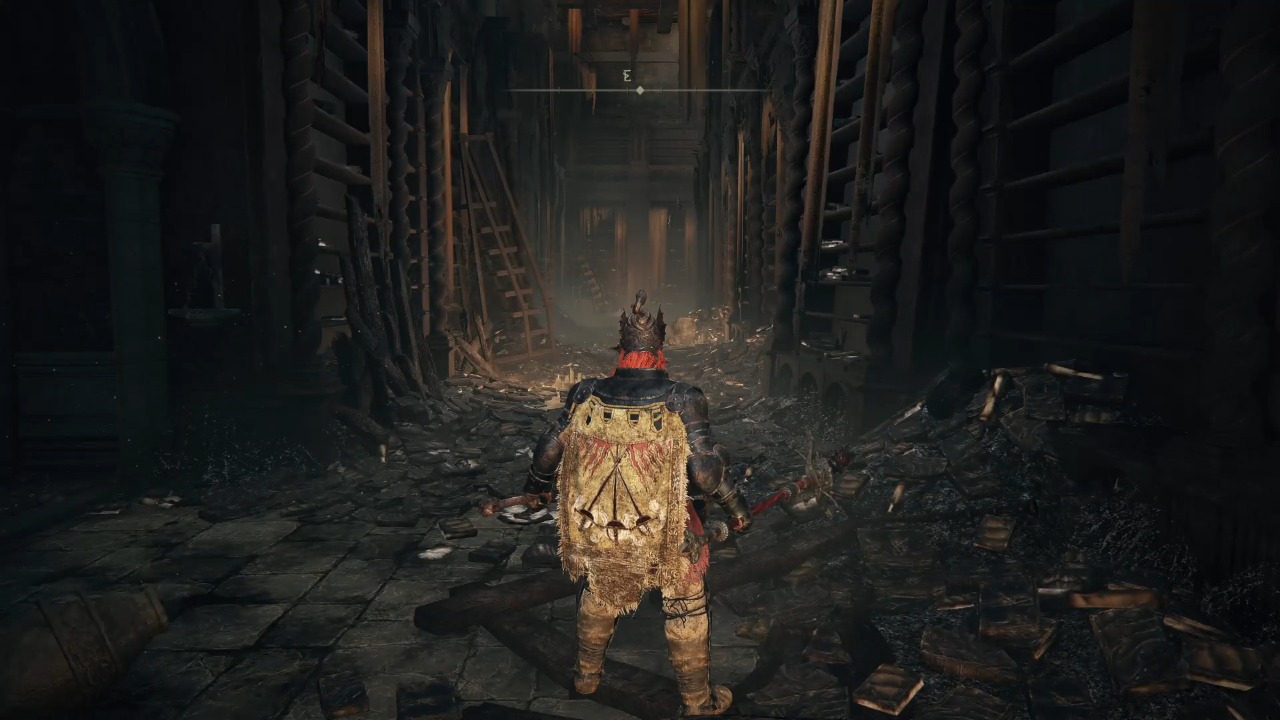
Mechanics ¶
Elden Ring has really innovated with the original mechanics of the Dark Souls games. There's now a dedicated button to jump and it makes all the difference when exploring verticality in areas. For example, you can jump up slight ledges or stairs. It also affects combat because you can now jump over attacks or jump over enemies entirely.
The horse-riding mechanics are another innovation that make exploration more enjoyable. It's now possible to glide through areas quickly and jump over ravines. It feels really good to control Torrent. This is the first horse-riding game I've played that makes controlling your horse effortless. It's much better than, say, Breath of the Wild, where your horse needs to be told what directions to turn a few seconds in advance. The double-jump mechanic makes jumping across gaps much safer.
Progression ¶
The world changes around you as you continue the main storyline. Your character gets stronger, NPCs die, and some early bosses turn into common enemies later. There are consequences for your actions - when you burn the erdtree, the capital gets covered in ashes. This aspect alone makes your progression much more meaningful because each action you take will have effects, influencing your future decision-making.
Difficulty ¶
One of Elden Ring's most identifiable characteristics is its innate difficulty. The enemies are challenging to fight, positioned in specific areas with movesets designed to cause the player suffering. However, because of the increased difficulty, it makes game progress all the more satisfying. Elden Ring feels very good to play when you can dodge every enemy's moves and wipe out an area flawlessly. The same applies for bosses too - the whole reason people love souls-like games is learning the skills to fight a boss and win. As a result, you feel stronger and more experienced as a player. In this game, progression means you learned skills that paid off. The game also rewards the player for defeating enemies and bosses with weapons, spells, and equipment. It's very satisfying.
At the same time, the difficulty always increases. The late game bosses are much harder than the ones at the beginning. Mini bosses you fought at the beginning of the game become normal enemies as time goes on. This means that you always need to learn new strategies and skills to progress. It's what makes the game difficult: rather than holding your hand, the game tells you to get stronger.
For those that cannot handle the difficulty due to disabilities or time investment, the game also provides players with tools to help them succeed in other ways[3]. Scadutree Blessings increase your damage negation. Golden Seeds increase the amount of healing flasks your character can hold. Sacred Tears increase the amount of health restored per flask. Summons like the Mimic Tear and Banished Knight Oleg exist to make your boss fights simpler. I believe FromSoftware has done a fantastic job refining the difficulty of Elden Ring.
Community ¶
The Elden Ring and greater souls community is generally very positive (with the exception of some toxic members, which I will focus on in a criticism below). They encourage players to fight hard bosses and give a lot of tips on defeating them. It feels justifying to struggle immensely on a boss, then go to online forums and see other players struggling in the same ways.
FromSoftware also invented the most underrated form of in-game communication called writing messages. A player can leave a message (and an emote) at a specific location for other online players to read and "applaud" or "disparage". These messages can be warnings, pointing out the location of a special item, or encouragement to help others. When a message you wrote gets appraised by another online player, it immediately refills your health bar. This is extremely helpful in boss fights and precarious enemy areas.
The part I love the most about this message-writing system is that it uses a word-bank. Instead of typing whatever you want, your messages can only be written using words from a word-bank in a specific format. The resulting message is automatically free of profanity and hate speech, and the format is iconic and charming. For example, you might see messages like "praise the I did it!", "hidden path ahead", and "could this be an item?". Regardless of the message restrictions, people always try to find ways to break the system. As a result, you'll find funny messages like "try finger, but hole", or "I wish I had a giant, but hole", or "amazing chest ahead". I absolutely love this system. Here are some of my favorite messages I found while playing through the game:
- first off, two handing and then time for head
- if only I had a giant... but hole...
- dog but hole
- if only I had a master...
- first off, think carefully, could this be a recklessness?
- bravery? but I want to go home...
- praise the calmness!
- up, dog?
- ahead, O ahead, horse!
- mist or beast!
- try throwing, Elden Ring...
- try crouching and then let there be dung
- likely weak foe
- jumping required ahead
- hole
- I want to go home... and then edge!
- Erdtree but dark!
- are you ready?!, butterfly!
- tree
- ahh, rain...
- likely snake
- clear sky
- lovable sort ahead, Offer lever
Elden Ring also uses bloodstains to aid online players. When you die in game, a bloodstain appears at your death location. Other players are able to view bloodstains to see the last five seconds of your character before they died. This allows you to learn from other players' mistakes and also leave some funny bloodstains in random locations to confuse other players.
Finally, Elden Ring also has a summoning system for multiplayer gameplay. You are able to summon your friends to play through certain areas or bosses together, but this is an area where Elden Ring has room for improvement. You can only summon in certain areas and when you defeat the boss of the area you can no longer summon in that area. It also means that other players can invade your world and try to kill you. I think they should make an option to play multiplayer perpetually. It would make these games easier to enjoy with friends.
Replayability ¶
Elden Ring's replayability is phenomenal. Because it is inherently a role-playing game, you have countless types of builds you can create with the number of weapons, skills, and armor sets you can combine. The number of equipment items you can choose from is mind-boggling: including the DLC, there are over 300 different weapons to choose from. It's really fun to create builds and share them with your friends. Even the social media platform-owning ferengi[4] has made one:
@elonmusk
Int/Dex build, so mostly mage with some weapon skills. Shield in left hand, staff in right with rapier & claws fast switch.
Change armor from heavy to medium for fast roll or tank.
Move talismans around a lot.
Many small hits in a row to damage stack is important.
Summon!
6:55 PM · May 9, 2022
SourceWhat makes a game even more replayable is the ability to replay it with friends. While there are flaws with the multiplayer summoning system I mentioned above, there is a Seamless Coop mod that makes real multiplayer feasible in Elden Ring.
Elden Ring also has many different endings depending on the choices you make and NPCs you talk to. This makes the game much more enjoyable on subsequent runs because you can interact with different NPCs and unlock different endings based on the outcomes. In my first playthrough, I unknowingly unlocked the frenzied flame ending and I didn't realize there were much happier endings.
Criticisms ¶
As much as I love this game, I still subject it to intense scrutiny. There are a few flaws this game could improve on, in order of most to least importance:
- Balance. Some builds are severely overpowered compared to other builds because of extremely powerful weapons, extremely powerful damage types, or the ability to trick a boss based on the mechanics of an Ash of War. When the game first released, every player was using Rivers of Blood due to its ability to almost instantly proc blood loss in a boss. On the other hand, there are some extremely cool weapons that nobody uses because they're too weak to reasonably use. FromSoftware has gradually improved the game's balancing in subsequent patches, but there is always room for improvement.
- Expectations. Some bossfights don't set proper expectations on what will happen in the fight. Two of my least favorite fights in the game are the Godskin Duo and the Scadutree Avatar because they don't clearly tell the player how to beat them. For the Godskin Duo, the fight doesn't indicate how the individual godskin enemies spawn or when they spawn. When you defeat one, it respawns over and over until the main health bar drops to zero. It would have been better if they removed the individual godskin enemy health bars, or if they made it so you only have to defeat each godskin enemy once. For the Scaudtree Avatar, it doesn't tell the player how many times they have to defeat them before the fight ends. Towards the end of my fight I was wondering if I had to run around the boss arena to look for special sunflowers to collect or specific structures to break to keep it from spawning. I think they should have shown how many times the sunflower would respawn in the healthbar.
- Questlines. FromSoftware is notorious for making hard to follow NPC quests. Most of the time NPCs don't say what they're doing or where they'll be next so you have to guess where an NPC is. It's sometimes not clear either what an NPC wants for their quest. Sometimes you have to present a certain item at a certain time and wait a certain period of time for something to happen.

- Fall Damage. It's often hard to judge how far your character can drop without dying. In most cases it's a very abrupt change from falling and landing with full health to falling and instantly dying. FromSoftware should improve on their next game and make fall damage an increasing number proportional to the height. It should be reasonable to expect a player with a larger healthbar to survive a fall and a player with a smaller healthbar to die from a fall.
- Discoverability.
New items and menu options are hard to find because there is no indication of them in the menu or inventory. I went through my entire first playthrough without realizing you could talk to Melina at most churches because the option didn't stand out in the menu. Similarly, if you receive a new item, you have to search through your entire inventory to find it to read its description and see its stats.FromSoftware fixed menu option discoverability in a patch which highlights new menu options and they fixed new item discoverability in the DLC with a "Recent Items" menu tab. - Toxicity. While this is no fault of the underlying game, some members of the game community can be incredibly toxic. Some players think you didn't actually beat the game if you used summons or powerful builds to the point where players will bully other players. It's sickening. At the end of the day, players should understand that these mechanics are built into the game for the player to use. It doesn't matter if you beat the game using no summons at rune level 1 or if you beat the game using Black Knife Tiche and a fast-procing bleed build.
- Performance. When I first played the game there were more than a few stutters and frame drops in every area. This is even more critical when you're fighting a boss and every frame matters. Performance has improved steadily since the game's release (likely due to patches) but there are still frame drops under specific circumstances (for example, fighting Promised Consort Radahn or using the heavy attack of the Lightning Perfume Bottle).
- Checkpoint positioning. Compared to previous souls-like games, I wish that the checkpoints of this game were spaced out more. Some sites of grace feel unnecessary because they are placed right next to other sites of grace. I like when every checkpoint feels like considerable progress.
Bonus ¶
Boss Ranking ¶
Here are my obligatory ranking lists for Elden Ring bosses.
Favorite bosses:
- Messmer the Impaler. He has such a cool intro and midway cutscene and his attacks patterns feel very crafted and clean. Each attack seamlessly transitions into the next attack. Fighting him almost feels like dancing. He's a cool fire twink.
- Maliketh, the Black Blade. His transformation is very cool and any enemy with a giant sword (Sif, Ludwig) feels amazing to fight. He also uses his boss arena in his attacks by jumping on pillars which is extremely cool.
- Putrescent Knight. The atmosphere of the arena combined with the boss music glorifies the fight. I think the Putrescent Knight also has really cool and elegant moves when he throws his cleaver and jumps off of his horse to do his guillotine move. The calmness of his moves and serenity of his theme really fits the area dedicated to St. Trina. His Putrescence Cleaver is my favorite boss weapon of the DLC.
- Divine Beast Dancing Lion. This bossfight feels deeply inspired by Chinese lion dances with the boss's design and music. I love that each of the bosses moves transform/adapt to the lion's current element as it switches between lightning, ice, and wind. It was also a pleasant surprise to find that the second dancing lion also had a deathblight phase.
- Bayle, the Dread. Bayle is a perfect foil to Placidusax in the base game. Both are really cool giant dragon fights, but Bayle has a lot of cool moves such as his tail whip, claw swipe, and laser fire breath that feel exhilarating to dodge. His second phase transition is terrifying combined with the music. Igon made the fight trivial in my streamed playthrough but you can be certain I'll be fighting him again in my free time.
- Rykard, Lord of Blasphemy. His first phase is so fun to fight. The serpent has really cool moves similar to Messmer's fight and the area looks absolutely gorgeous. That and I love that you need to fight him with a wind-bursting serpent spear.
- Malenia, Blade of Miquella. When I first fought Malenia I thought she was unfair and frustrating. After fighting her over and over again, I love how fluid her movesets are and powerful she claims she is when she says she has "never known defeat". It makes it extremely satisfying to sidestep her moves and be able to effectively dodge her waterfowl dance.
- Midra, Lord of Frenzied Flame. Midra is everything I wanted in a frenzied flame boss. I love the concept of frenzy and madness and I love the way they incorporated it into this boss. He walks like he has no care in the world and floats around effortlessly. I also love the discordant melodies from the choir in his soundtrack.
- Godfrey, First Elden Lord. Godfrey's bossfight is the perfect balance between refined righteous knight and unhinged bloodthirsty warrior. I love his transition from a civilized axe fight to a brawl with punches and kicks. The music in the second phase makes the fight terrifying.
- Morgott the Omen King. It's the perfect form of progression to first defeat Margit at the bridge, defeat him a second time in the outskirts outside the capital, then defeat him within the capital as a king. His moves advance in difficulty and his speed increases as well.
Honorable mentions go to the Crucible Knight, the Bloodhound Knight, and Leonine Misbegotten. These three are the best mini-bosses because of their fantastic movesets and looks. I love each of these fights but I don't think I can rank them on the same scale as the remembrance bosses and demigods.
Hardest Bosses:
- Promised Consort Radahn. I already spoke about it many times in my playthrough but they really went all out on difficulty for this boss. A lot of the after-effect hits and premonition moves of his second phase are almost impossible to dodge. Even if you dodge them, it's extremely hard to find openings to attack[5].
- Malenia, Blade of Miquella. Her waterfowl dance and phantom summoning attacks are deadly. It's scary every time she does them because both attacks can instantly kill you.
- Messmer the Impaler. He performs a ton of fire attacks that can catch you off guard. In addition, his "heat-seeking" flame attacks make it much harder to find an opening to create distance or heal. It reminds me a bit of the Godskin Duo input-reading black flame attacks.
- Fire Giant. Because of the damage scaling, all of his attacks can easily one-shot your character. I have yet to fight with a character that can withstand his fire breath, or rolling attacks.
- Alecto, Black Knife Ringleader. She's extremely fast for a black knife assassin and doesn't stagger as easily as you'd think. Combined with her flame attacks, she is quite formidable if you have a medium or heavy build.
- Maliketh, the Black Blade. Similar to Alecto, his flame attacks can gradually sap your health to the point of death if you're not careful. He uses a combination of range and area of effect attacks that make it difficult for builds of any kind.
- Mohg, the Lord of Blood. If you don't use the Purifying Crystal Tear for this fight, you'll be required to use 3-4 flasks during the phase change. He additionally leaves trails of bloodflame everywhere he walks, turning the bossfight into a game of "the floor is lava".
- Starscourge Radahn. Because of his sheer size and speed, it's hard to land an attack on him while dodging other attacks. His gravity attacks in his second phase are very hard to dodge, plus his damage in general is very high due to his strength.
- Rellana, Twin Moon Knight. Similar to Messmer, her attacks all blend together seamlessly, making it very difficult to find an opening to attack. Both her and Messmer are bosses on a completely different scale of difficultly. Her ranged attacks also make the fight even more tedious.
- Rykard, Lord of Blasphemy. When he starts spawning skulls, the bossfight becomes a game of how many times you can panic roll before running out of stamina. His sword attack at the end is very hard to dodge. Without that move, the rest of the fight is reasonable.
My Build ¶
I have two builds: one from my original playthrough of the base game and one from the playthrough I recorded to play the Shadow of the Erdtree DLC.
Original Build ¶
Here's my original build I called "Derek". I can't really accurately recount my levels because since I've beaten the game I've increased all my levels and boosted arcane to grind for rare items but here is the equipment setup I used throughout the majority of the game.

| Armor |
|
| Talismans | |
| Weapons |
|
| Physick | |
| Other items |
|
LVL: 200 -------- VIG: 47 MIND: 12 END: 40 STR: 38 DEX: 50 INT: 7 FAI: 12 ARC: 46 -------- Flasks: 14 +12
My time spent in this save is 162:50:35.
DLC Build ¶
My DLC character "Lemon Granny" was a lot more sporadic in terms of build. I changed weapons multiple times throughout the playthrough because I wanted to try different weapons. Unfortunately, some of my final build was specifically designed for fighting against the Promised Consort.
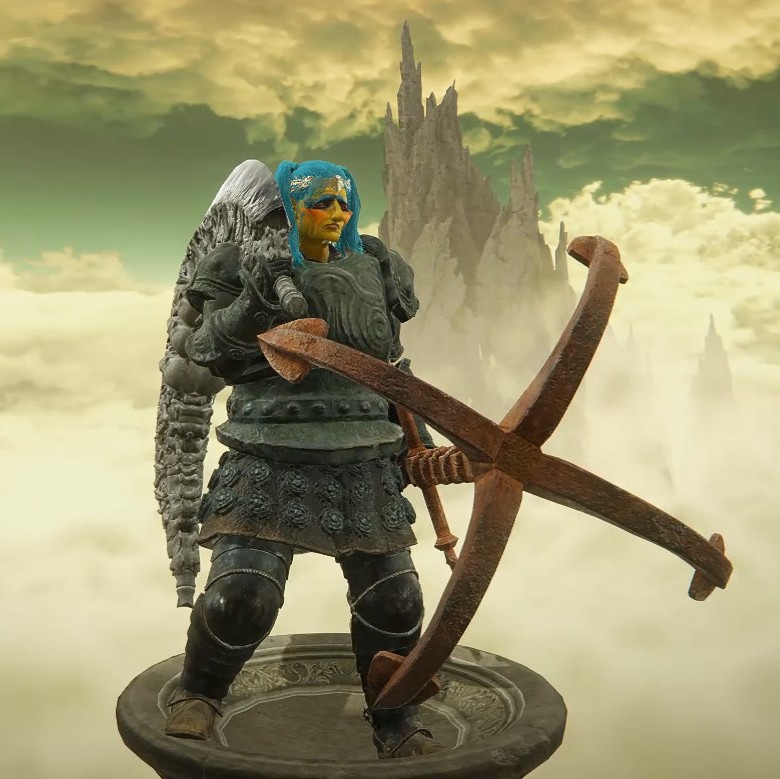
| Armor |
|
| Talismans |
|
| Weapons |
|
| Physick | |
| Other items |
|
LVL: 183 -------- VIG: 60 MIND: 11 END: 42 STR: 67 DEX: 15 INT: 10 FAI: 9 ARC: 51 -------- Flasks: 13 +11 -------- Scadutree Blessing: 19 Revered Ash Blessing: 9
My time spent in this save is 101:47:17.
Tips and Tricks ¶
If you're having trouble adjusting to the difficulty of Elden Ring or you're new to FromSoftware games, here are some tips and tricks to make your gameplay easier and more enjoyable.
- Don't play with mouse and keyboard. Even if you've never played with a controller before, you'll have a much easier time piloting your character and the camera using joysticks than with keys. Trust me - I first tried very hard to play Dark Souls with a keyboard before my friend convinced me otherwise. And I'm glad I was able to relearn with a controller.
- In most boss fights it's actually safer to stand close to the boss rather than far away. A lot of bosses (especially Promised Consort Radahn) have large area of effect attacks that hit far away places a player might hide. If you stand closer, it also makes it easier to see when and where the attacks are coming from, and you don't have to worry as much about if you're close enough to hit the boss.
- Learn to roll. Rolling helps you learn enemy attack patterns faster than using a shield because you'll instinctively try to hide behind your shield. With rolling, you have to move or you'll get hit.
- Try changing your build. If you're struggling with a boss or area, try changing your equipment. Wear heavier armor, try a different weapon type, or even undergo rebirth to move around your levels. You may find playing much more enjoyable using a different weapon type.
- Be patient. If you die to a boss 20 times in a row, try taking a break. It's much harder to fight a boss until they die than it is to slowly chip away at learning a boss while leveling up in the meantime.
Memes ¶
I love Elden Ring's memes almost as much as I love Elden Ring. Here are some of my favorites. You can see more of my favorite moments in the highlights of each video in my playthrough.
view memes

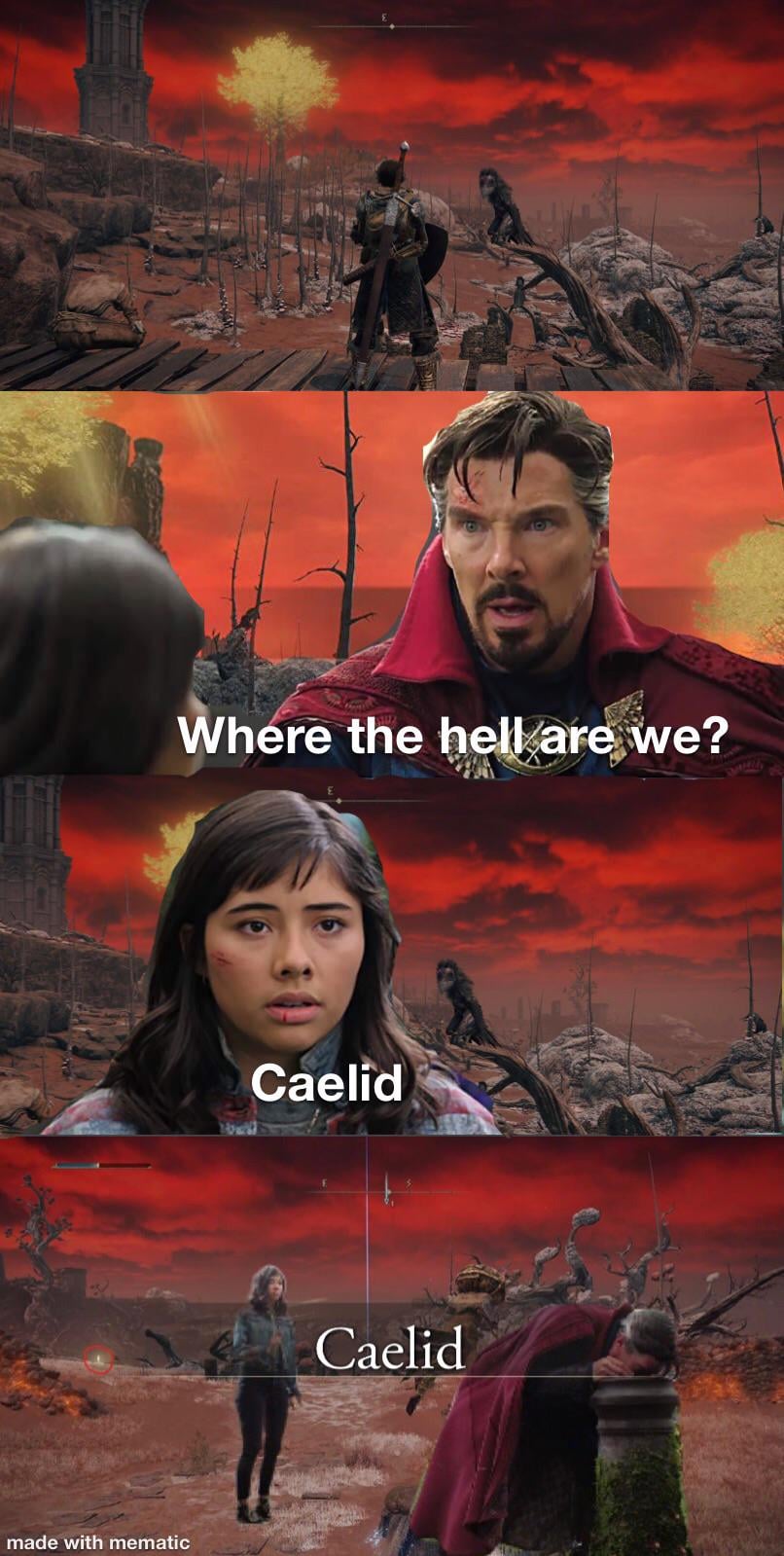
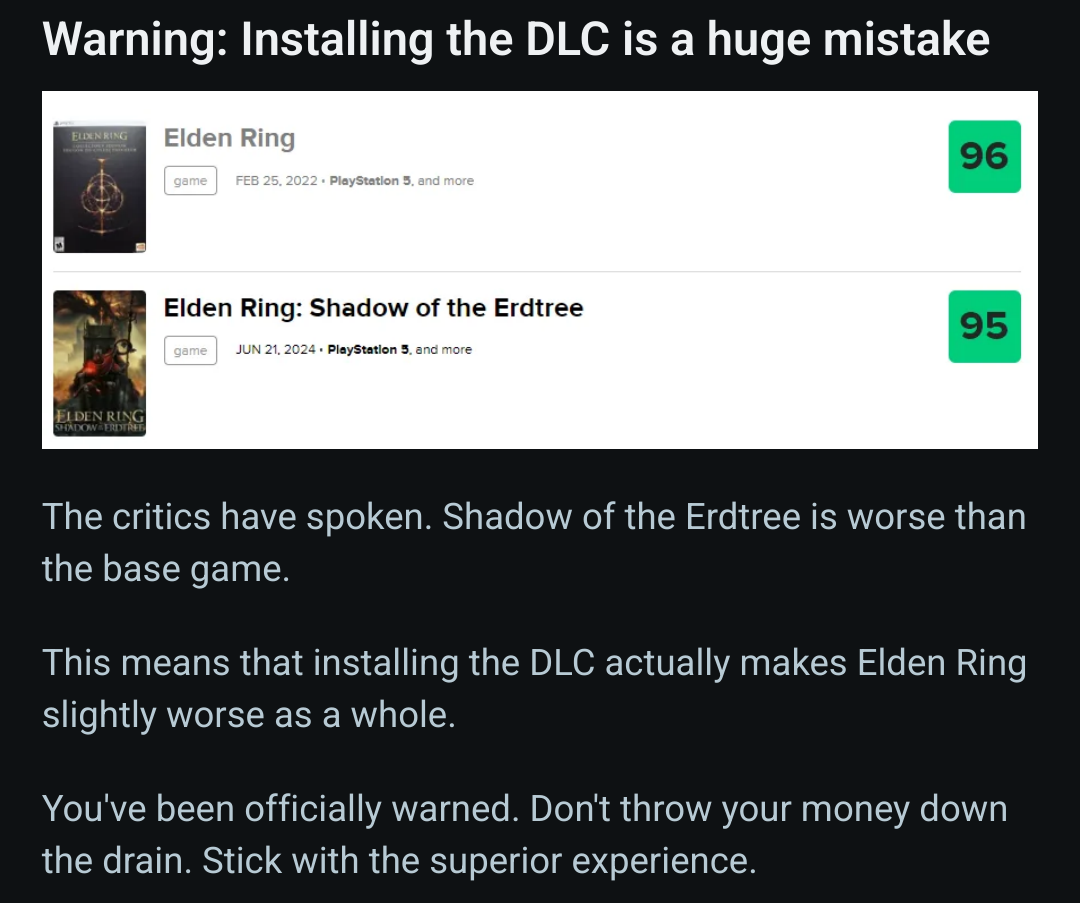
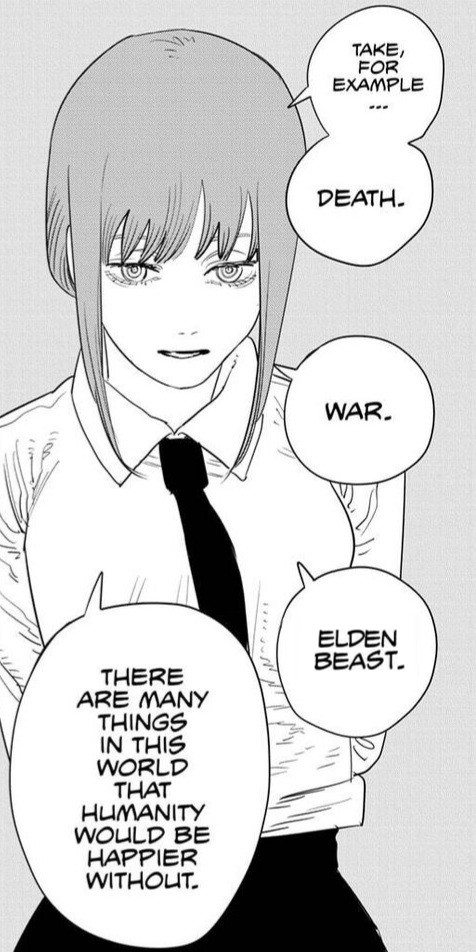
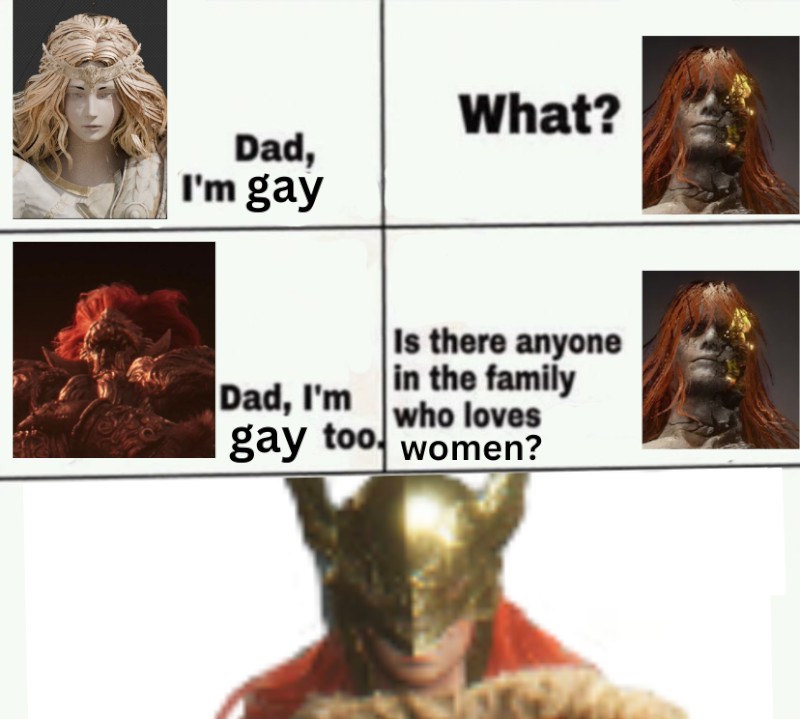
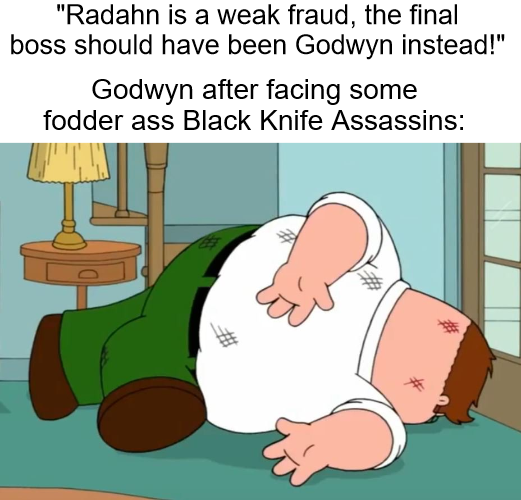


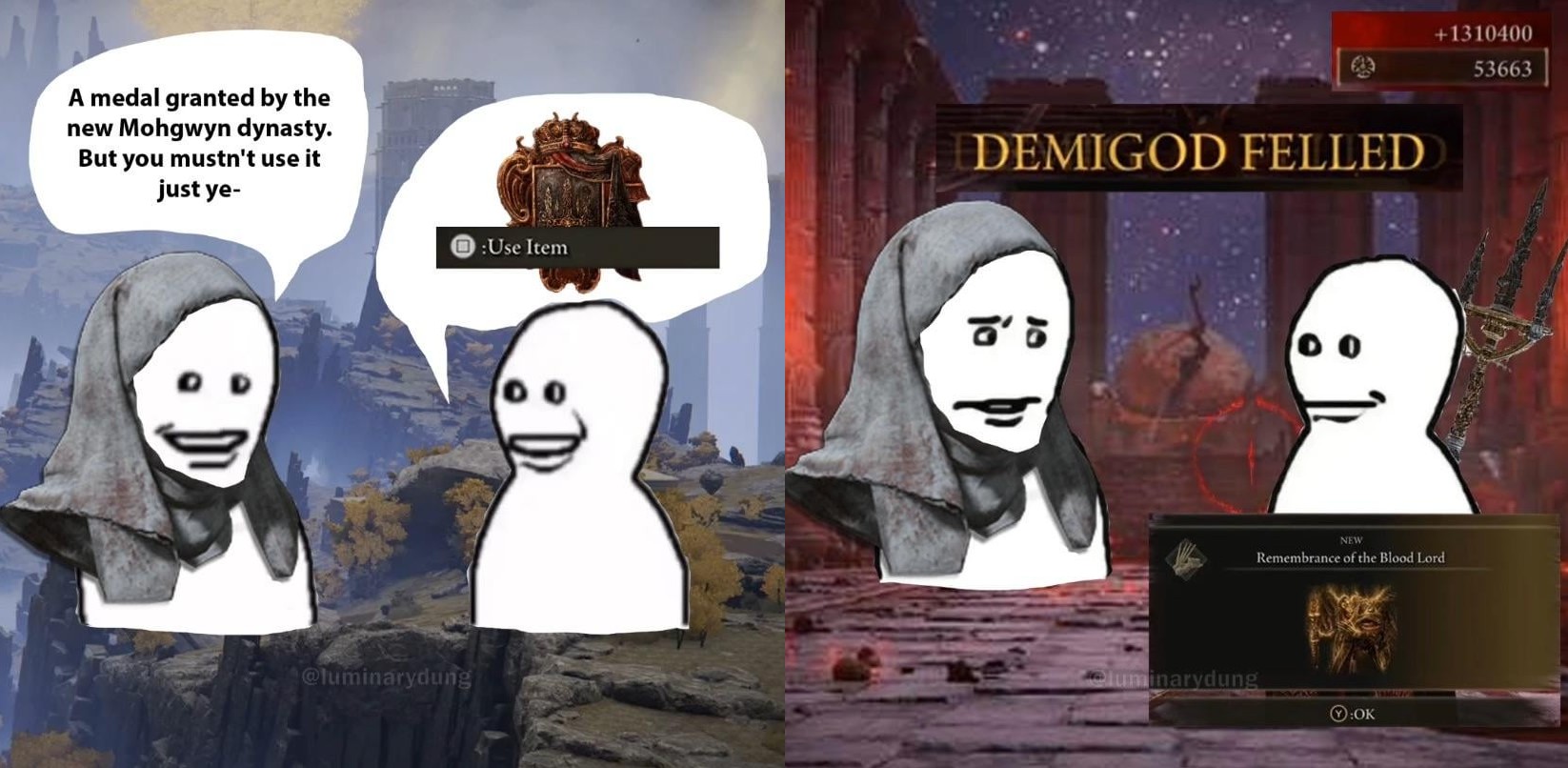



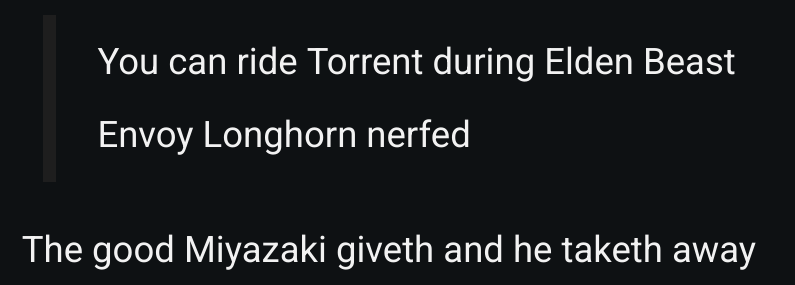
Conclusion ¶
When I originally played and rated this game I gave it an 8.8; however, after playing through the Shadow of the Erdtree DLC, I've bumped up my final rating because FromSoftware listened to the community fixed a lot of flaws of the original game through patches and the DLC itself. I give Elden Ring a 9.1 for its for its amazing boss design, innovative new game mechanics, and beautiful visuals and storytelling. This game is a "must play" for anyone who enjoys middle-earth fantasy and a challenge when fighting enemies. This game is also very replayable if you love role-playing games.
Once again, if you want to experience the game without playing it, you can watch my playthrough of the game here.
It's still an ongoing passive goal of mine. The DLC has made it even more difficult by adding tons of new items, but it's satisfying to have a save containing every single item without cheats. ↩︎
I spent nearly 10 hours trying to defeat Ornstein and Smough on my first playthrough. I was stubborn and refused any summons or video help and did it all on my own. It gave me a lot more patience for video games. ↩︎
Alanah Pearce has a great commentary on how Elden Ring allows you to adjust the game's difficulty using in-game mechanics. ↩︎
Someone else made the connection. I can't take credit here. ↩︎
On September 11, 2024 FromSoftware released a patch that supposedly makes the final fight more forgiving with slower attacks and bigger dodge windows. I have not fought him since I beat him in my original playthrough so I am only speaking of my "pre-nerf Radahn" experience. ↩︎